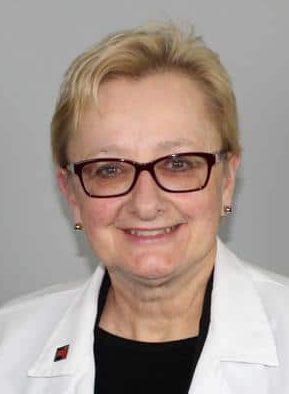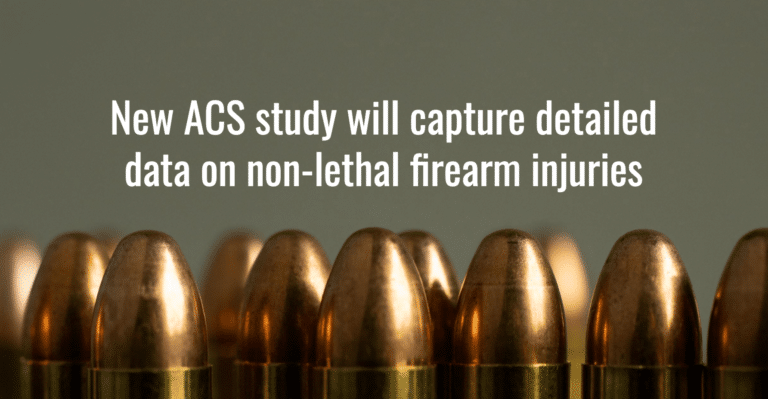Trauma researchers have extensive data on fatal gun injuries in the United States. But much less is known about firearm injuries that do not result in death. A new prospective multi-center study led by the ACS Committee on Trauma (COT) aims to fill that gap.
“The goal of this study is to get a better understanding of the circumstances of non-lethal firearm injuries,” said Deborah Kuhls, MD, FACS, FCCM, professor of surgery at UNLV School of Medicine and medical director of the Trauma ICU at University Medical Center of Southern Nevada.
“Ultimately, our aim is to identify the individual and community-level risk factors for these injuries so we can target our injury prevention efforts,” Dr. Kuhls said.
Full-spectrum view of non-lethal shootings
The new ACS study is funded by a grant from the National Collaborative for Gun Violence Research. The study will use the infrastructure of the Trauma Quality Improvement Program (TQIP) to develop a nationally representative dataset on non-lethal firearm injuries.
Dr. Kuhls and Avery Nathens, MD, MPH, PhD, are co-principal investigators of this study. Dr. Kuhls is the assistant dean for research at the UNLV School of Medicine and the Immediate Past Chair of the ACS COT Injury Prevention and Control Committee. Dr. Nathens is medical director of trauma quality programs at the American College of Surgeons.

“U.S. trauma centers that participate in TQIP will have the opportunity to take part in the study by collecting additional data elements from patient charts that relate to individual patient and community risk factors for injury,” Dr. Kuhls said. “Trauma registrars already review charts and enter data in the TQIP database, and by adding several other data elements, we will have a much more complete picture of risk factors and circumstances of firearm injuries.”
Dr. Kuhls described several data elements that the study will capture: “For example, if the shooting was intentional, was the shooter a stranger or someone the victim knew? If the victim knew the shooter, was he or she an intimate partner? Did the shooter also become a victim?”
The study will also collect additional data on injury location and other factors. Did the shooting take place at home? In a public place? In the workplace? What type of weapon was used? If the shooting was unintentional, what were the circumstances and setting?
“We also want to capture data on the mental health aspects of these shootings,” Dr. Kuhls said. That will help researchers understand more about individual risk factors for firearm injury. It could also help researchers gain a better understanding of suicide attempts.
“Suicide rates among older adults in the U.S. are very high, particular among older white males. At the same time, suicide rates among the very young are alarmingly high and growing very quickly,” Dr. Kuhls said. “So one of our aims with this study is to get a better understanding of the circumstances surrounding these injuries.”
According to Dr. Kuhls, most of the additional information gathered by this study should already exist in patient medical records.
Data collected in this study will be linked by zip code to community- and neighborhood-level indices and data sources to explore the association between non-lethal firearm injury and social determinants of health.
Timely look at gun violence
During the COVID-19 pandemic, both deaths from gun violence and firearm sales have increased across the country, underscoring the need for rigorous research that can inform effective injury prevention, including gun safety training.
“We must answer the question: What works and what doesn’t to reduce gun violence?” said Andrew Morral, director of the National Collaborative for Gun Violence Research. “Studies like the ACS Committee on Trauma’s fill a critical gap in our understanding of gun violence and how to prevent it.”
The research team will soon be recruiting trauma centers to take part in the study. According to Dr. Kuhls, Level I and Level II trauma centers treat the majority of firearm injuries, but any TQIP center in the U.S. can participate.
Data collection will begin in early 2021 and will take place over one 12-month period. To optimize data quality, the study team will develop a detailed data dictionary and offer special training for trauma registrars.
The study team will reach out to all U.S. TQIP trauma centers in early fall to solicit their interest. In the meantime, trauma program leaders interested in taking part in the study can contact the research team by emailing tqip@facs.org.
Robert Fojut is the editor of Trauma System News.

